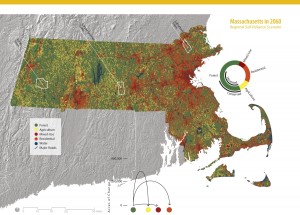Ethan Goss
We are in the midst of an age of increased urban sprawl, greater demand for land, and increasingly fragmented forest land.This study looks at programs that make it more economically favorable for family forest to keep their forest as forest, rather than sell it off for development. The focus of the study was on the mitigation of property taxes on forested land through land use programs that give reduction in property taxes and conservation easements that potentially give land owners a separate source of income. There is a great need for a study like this to raise awareness of these programs. They found that of the forest owners that were eligible to be enrolled in the current-use program, only 15% are actually enrolled in it. The study was conducted in the Deerfield Watershed Basin because of the high amount of forest cover and the forest ownership patterns that are indicative of much of the Northeast.
The researchers took five different landownership scenarios:
Scenario A: Status Quo
Scenario B: Timber management only, pay full property taxes
Scenario C: Timber management and current-use (Chapter 61) tax reduction
Scenario D: Sale of conservation easement and tax reduction
Scenario E: Timber management, current use, and the sale of a conservation easement
And calculated the NPVs of the cash flow including all of the tax outputs and revenue from timber sales. In all cases but the 150 ac low valueownership lot did not get enough revenue from the sale of the timber to account for the amount of property taxes. This resulted in a negative NPV. In contrast, when timber sales and tax reductions from the current-use program were combined the NPV was positive. They also found that that the current-use reduction had a greater effect on the NPV than the timber sales. When timber sales were coupled with the sale of development rights the NPV was even higher than either of the previous scenarios. This was increased even further when all three options were combined.
Family forest owners are not in as much peril as they are made out to be. If the owners use these various techniques it is possible for them to have a net positive income over a 30 year period. Due to the low current enrollment in these programs, D’Amato suggests that outreach programs should be started to raise awareness of these programs. This study also suggests that the government should recognize the ecosystem benefits of forests that are not currently managed under a management plan and provide them with a program to ease the burden of property taxes.
The full study can be found HERE

